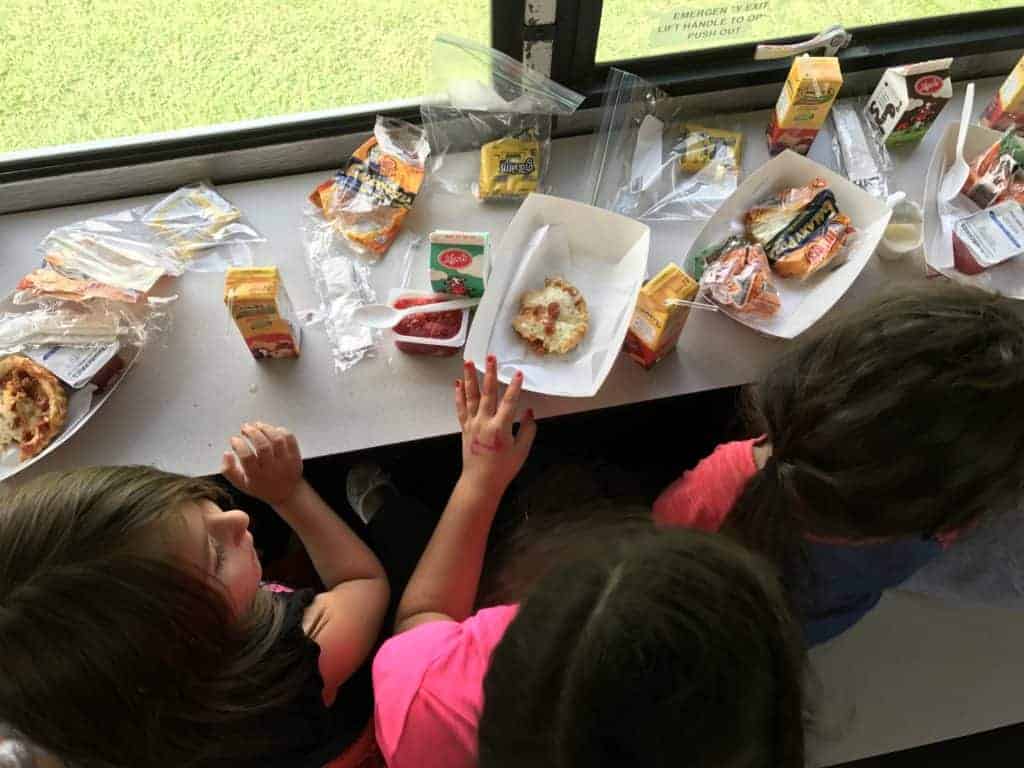From D.C. to the Cafeteria: A School Meals Primer

Get stories like these delivered straight to your inbox. Sign up for The 74 Newsletter
For more than 75 years, schools across the United States have provided more than just an education — they’ve also provided low or no-cost school meals, from breakfast to lunch to afterschool snacks. Research points to numerous benefits of school meals, including their role in , and . Since March 2020, the COVID-19 pandemic has fueled increases in and ushered in that change the way school meals operate, including allowing schools to serve through the 2021-22 school year.
Now, school meals are at a pivotal moment. Will school nutrition budgets recover from the ? Will the innovations accelerated by the pandemic, such as , become long-term solutions? Beyond the cafeteria, how can school meals serve as an instructional intervention to improve student learning?
To understand what the future of school meals could hold, we first need to understand how they currently operate. Let’s begin with a primer on key school meals programs, how students qualify for free or reduced-price meals, and their nutritional standards.

Key programs
In 1946, the National School Lunch Act. It created the National School Lunch Program (NSLP) to “safeguard the health and well-being of the Nation’s children and to encourage the domestic consumption of nutritious agricultural commodities and other foods.” Since then, school meals have evolved to encompass numerous programs that are administered at the federal level by the Food and Nutrition Service (FNS) of the U.S. Department of Agriculture (USDA). Here’s a brief overview of key FNS programs.
- (NSLP): The flagship and largest child nutrition program, the NSLP provides low or no-cost lunches served in public and nonprofit private schools and residential child care facilities. In 2019, roughly were served to children nationwide, with 74% of them being free or reduced-price.
- (SBP): First , the SBP was made permanent by Congress in 1975. It provides low or no-cost breakfasts served in public and nonprofit private schools and residential child care facilities. In 2019, roughly were served to children nationwide, with 85% of them being free or reduced-price. compared to school breakfast, and such as breakfast in the classroom and grab-and-go carts aim to increase participation.
- (CAFCP): , the CACFP provides reimbursements for meals and snacks served to children or adults enrolled at participating child care centers, day care homes, and adult day care centers. It also covers reimbursements for meals served to youth during afterschool programs and children living in emergency shelters. In 2019, roughly were served through the program, with 80% of them being free or reduced-price.
- (SFSP): Also known as the Summer Meals Program, the SFSP provides free meals to kids and teens in low-income areas when school is out for the summer. Unlike other programs that are only administered by schools and districts, the SFSP can be administered by a variety of groups, including camps, local governments, faith-based groups, and other nonprofits. Another key difference is that all meals under the SFSP are free to children ages 18 and under. In 2019, roughly were served to children through the program. Amid COVID-19, , causing a large increase in the compared to the NSLP and SBP.
- (SSO): Available for schools that already operate the NSLP or SBP, the Seamless Summer Option provides a streamlined option for schools to continue providing meals during the summer months. School food authorities participating in NSLP or SBP apply to operate the SSO through their state governing agency. Once approved, SSO allows schools to serve free meals to children ages 18 and under from low-income communities using the same rules and reimbursement rates as the NSLP or SBP.
Qualifying for free or reduced-price meals
Since the pandemic began, the USDA has allowing schools to provide free meals to all students regardless of their eligibility. That waiver is currently set to expire at the end of June 2022.
Even without this waiver, the (CEP) allows qualifying schools and school districts to offer no-cost meals to all students — more on that below.
However, for non-CEP schools and districts, there are usually : direct certification, categorical eligibility, or based on household income.
1. Children in households that participate in the Supplemental Nutrition Assistance Program (SNAP) are , which schools do via a data matching system. Additionally, 27 states offer .
2. Other categories that are automatically eligible for free meals include foster, migrant, homeless, or runway youth, those enrolled in Head Start, and children from households that participate in Temporary Assistance for Needy Families (TANF) or the Food Distribution Program on Indian Reservations (FDPIR). Schools can use state data or can coordinate with liaisons for homeless or migrant youth to certify categorical eligibility. However, some students may be missed in this process and therefore have to fill out a school meal application.
3. If a student isn’t eligible through direct certification or categorical eligibility, households can fill out a school meals application to . Children in households with incomes at or below 130% of the poverty level are eligible for free school meals, while those in households with incomes between 130% and 185% of the poverty level are eligible for reduced-price meals, meaning they will pay no more than 30 cents for breakfast and 40 cents for lunch. Meals must be paid for in full for children in households above 185% of the poverty level, with meal prices varying by school district.
Providing free meals to all students
The (CEP) allows high-poverty schools and districts to provide free school breakfast and lunch to all students. as part of the Healthy, Hunger-Free Kids Act of 2010 and available nationwide beginning in 2014, CEP improves access to school meals and reduces paperwork and administrative costs for schools. To qualify, 40% or more of students in a given school or district must be considered “identified students” — those who are certified eligible for free school meals without a household application due to direct certification.
In the , 33,171 schools and 5,479 school districts nationally participated in the program, with more than 15.5 million children attending CEP schools. Rather than collect household applications, CEP schools are reimbursed using a formula based on the percentage of students categorically eligible for free meals based on participation in means-tested programs. The Food Research and Action Center maintains to determine which schools are eligible or near-eligible for CEP.
Nutrition standards
In order to receive federal reimbursement for school meals served through the NSLP and SBP, schools must meet strict nutritional requirements, also referred to as the meal pattern. Following the Healthy, Hunger-Free Kids Act of 2010, the to align them with the latest dietary guidelines.
The aim to make school lunches and breakfasts more nutritious, including increasing the availability of fruits, vegetables, and whole grains; limiting the amount of sodium, saturated fat, and trans fat; and meeting certain calorie limits. The Healthy, Hunger Free Kids Act also resulted in sold within schools, also known as “competitive foods” since they compete with the traditional meals served in the cafeteria.
A found that the overall nutritional quality of school lunches increased by 41% between the 2009-10 and 2014-15 school years, before and after the stricter guidelines went into place. And, a found that schools were the single healthiest place that children consumed food, with grocery stores, restaurants, entertainment venues, and food trucks all offering meals with lower nutritional quality.
Glossary
- : Child and Adult Care Food Program; federally assisted meal program that provides reimbursements for meals and snacks served to eligible children and adults who are enrolled at participating child care centers, day care homes, and adult day care centers.
- : Community Eligibility Provision; Allows schools and school districts in low-income areas to serve breakfast and lunch at no cost to all enrolled students without collecting household applications. Schools are instead reimbursed using a formula based on the percentage of students who are categorically eligible for free meals based on their participation in other means-tested programs.
- : Foods sold or available in schools outside of the federally reimbursable school meals programs, such as via a la carte lines and vending machines.
- A process that allows states and school districts to certify eligible children for free meals without the need for household applications. The 2004 Child Nutrition and WIC Reauthorization Act requires school districts to directly certify students whose households participate in the Supplemental Nutrition Assistance Program (SNAP) through a data-matching system.
- : Food and Nutrition Service; works to end hunger and obesity through the administration of 15 federal nutrition assistance programs including school meals and the Supplemental Nutrition Assistance Program (SNAP).
- : Healthy, Hunger-Free Kids Act; 2010 legislation that reauthorized child nutrition programs to expand access and improve nutritional quality.
- Meal pattern: Establishes criteria that school meals must meet in order to qualify for federal reimbursement. For example, meal patterns dictate the minimum of various types of foods (fruits, vegetables, grains, meats, milk) that school meals must contain. Meal patterns vary depending on grade level.
- : National School Lunch Program; federally assisted meal program providing low-cost or free lunches to children in public and nonprofit private schools and residential child care institutions.
- : School Breakfast Program; federally assisted meal program providing low-cost or free breakfasts in schools and residential childcare institutions.
- SFA: School Food Authority; administrative unit that is responsible for the provision of school food services within one or more schools and has the legal authority to operate FNS programs. The SFA receives federal meal reimbursements and is responsible for ensuring eligibility guidelines and criteria are met. This may be a single school district, several school districts, or individual schools.
- Reimbursable meal: A meal that qualifies for reimbursement with federal funds because it has met USDA meal requirements and nutrition standards, was served to an eligible student, and was priced as an entire meal rather than based on individual items.
- : Summer Food Service Program; federally-funded program that reimburses operators who serve free meals and snacks to children ages 18 and younger in low-income areas.
- : Seamless Summer Option; program that allows schools participating in the NSLP or SBP to continue serving meals during school breaks using the same rules and reimbursement rates as the NSLP or SBP.
- : United States Department of Agriculture; provides leadership on food, agriculture, natural resources, rural development, nutrition, and related issues. Operates numerous federal agencies, including the FNS.
This article is the first in a series looking at the future of school meals from policy to practice.
This first appeared on and is republished here under a Creative Commons license.
Get stories like these delivered straight to your inbox. Sign up for The 74 Newsletter
;)